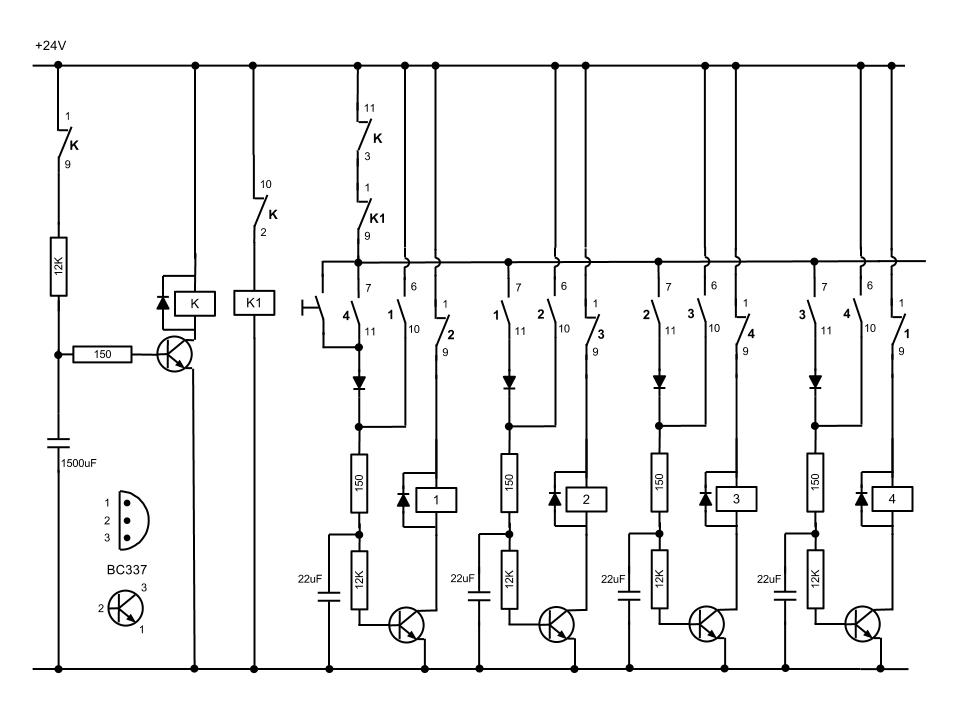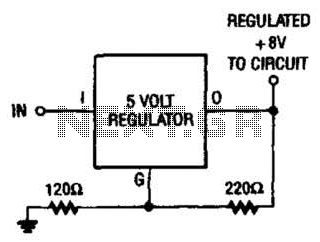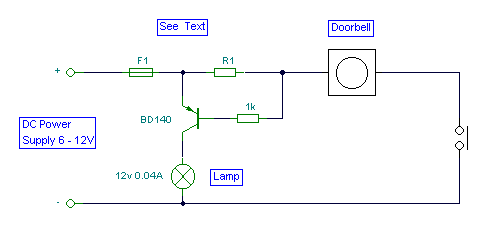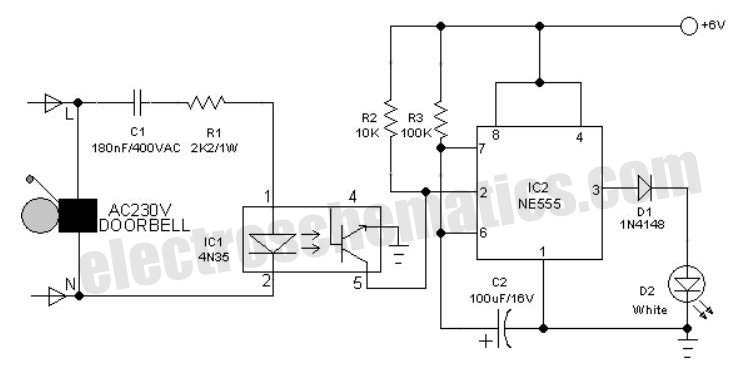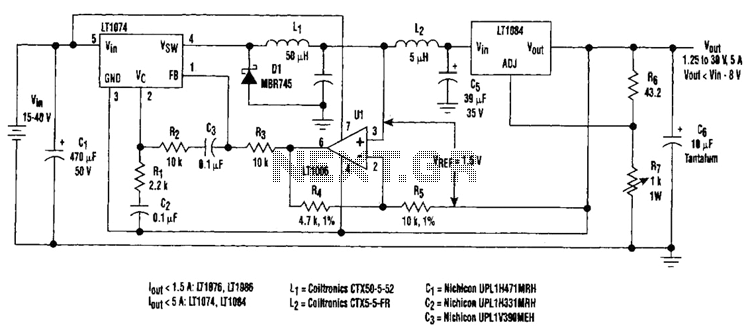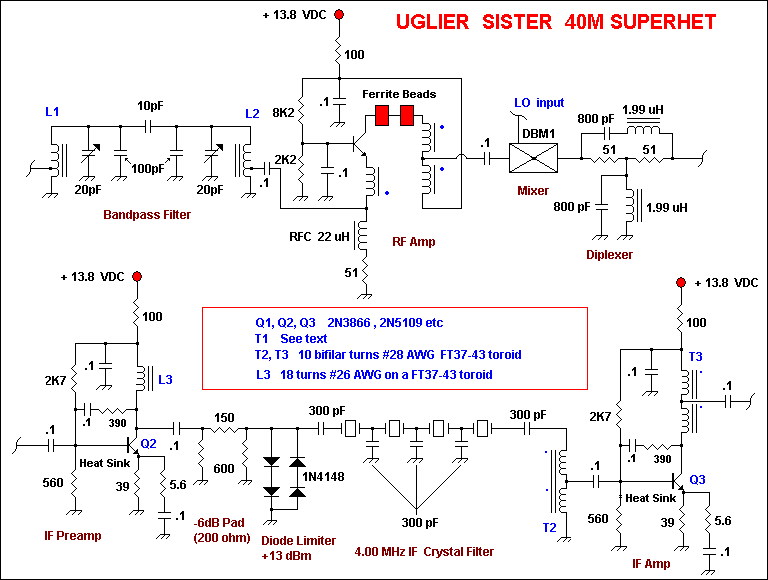
Doorbell circuit using NE555 IC
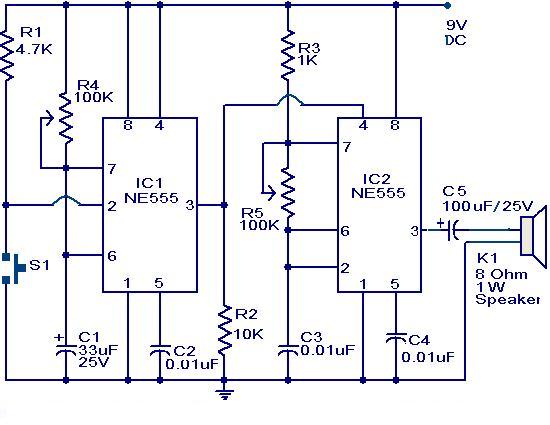
The primary component of this circuit is a doorbell utilizing two NE555 timer ICs. When the switch S1 is momentarily pressed, the speaker produces a bell sound, which is determined by the time period of the monostable multivibrator configured around IC1. Upon pressing switch S1, IC1 is triggered at pin 2, causing pin 3 to output a high signal for a duration set by the resistor R4 and potentiometer R5. Once IC1 returns to its stable state, IC2 activates, outputting a high signal that generates a bell sound through the speaker. IC2 is set up as an astable multivibrator, with its oscillation frequency adjustable via potentiometer R5. By varying the values of R4 and R5, the tone of the bell sound can be modified.
The circuit operates on the principle of two distinct configurations of the NE555 timer ICs. The first NE555 timer (IC1) is configured in monostable mode, which means it produces a single output pulse when triggered. This pulse duration is controlled by the resistor R4 and the potentiometer R5, which together define the time period for which the output remains high. The timing can be adjusted to suit various applications, providing flexibility in the duration of the bell sound.
When the switch S1 is pressed, it sends a low signal to pin 2 of IC1, activating the monostable multivibrator. The output at pin 3 goes high for the time period determined by the RC time constant formed by R4 and R5. This output triggers the second NE555 timer (IC2), which is configured in astable mode. In this configuration, IC2 continuously oscillates between high and low states, generating a square wave signal that drives the speaker.
The frequency of oscillation of IC2 is influenced by the resistance values of R5, which is a potentiometer allowing for real-time adjustments to the frequency. This feature enables the user to modify the tone of the bell sound produced by the speaker, thus providing a customizable auditory signal. The interaction between the two timers allows for a distinct and adjustable doorbell circuit that can be tailored to individual preferences or requirements.
In summary, this doorbell circuit effectively utilizes the NE555 timer ICs in both monostable and astable configurations to create a versatile and adjustable bell sound, with user-friendly controls for both duration and tone.The main part of this circuit Doorbell two timer NE555 ICs. When someone hit the switch S1 momentarily, the speaker emits a sound of the bell, if the time period of the monostable multivibrator built around IC1. When the switch S1 pressed, IC1 is enabled in your pin 2 and pin 3 output is high for a period of time previously set by the values of R4
and POT POT R5. When ofIC1 restores the IC2 output is high and starts to swing to make a bell sound through the speaker. The IC2 is configured as an astable multivibrator whose oscillation frequency can be varied with the help of POT R5.
By adjusting the values of R4 and R5, changes in tone are possible 🔗 External reference
The circuit operates on the principle of two distinct configurations of the NE555 timer ICs. The first NE555 timer (IC1) is configured in monostable mode, which means it produces a single output pulse when triggered. This pulse duration is controlled by the resistor R4 and the potentiometer R5, which together define the time period for which the output remains high. The timing can be adjusted to suit various applications, providing flexibility in the duration of the bell sound.
When the switch S1 is pressed, it sends a low signal to pin 2 of IC1, activating the monostable multivibrator. The output at pin 3 goes high for the time period determined by the RC time constant formed by R4 and R5. This output triggers the second NE555 timer (IC2), which is configured in astable mode. In this configuration, IC2 continuously oscillates between high and low states, generating a square wave signal that drives the speaker.
The frequency of oscillation of IC2 is influenced by the resistance values of R5, which is a potentiometer allowing for real-time adjustments to the frequency. This feature enables the user to modify the tone of the bell sound produced by the speaker, thus providing a customizable auditory signal. The interaction between the two timers allows for a distinct and adjustable doorbell circuit that can be tailored to individual preferences or requirements.
In summary, this doorbell circuit effectively utilizes the NE555 timer ICs in both monostable and astable configurations to create a versatile and adjustable bell sound, with user-friendly controls for both duration and tone.The main part of this circuit Doorbell two timer NE555 ICs. When someone hit the switch S1 momentarily, the speaker emits a sound of the bell, if the time period of the monostable multivibrator built around IC1. When the switch S1 pressed, IC1 is enabled in your pin 2 and pin 3 output is high for a period of time previously set by the values of R4
and POT POT R5. When ofIC1 restores the IC2 output is high and starts to swing to make a bell sound through the speaker. The IC2 is configured as an astable multivibrator whose oscillation frequency can be varied with the help of POT R5.
By adjusting the values of R4 and R5, changes in tone are possible 🔗 External reference
Warning: include(partials/cookie-banner.php): Failed to open stream: Permission denied in /var/www/html/nextgr/view-circuit.php on line 713
Warning: include(): Failed opening 'partials/cookie-banner.php' for inclusion (include_path='.:/usr/share/php') in /var/www/html/nextgr/view-circuit.php on line 713
